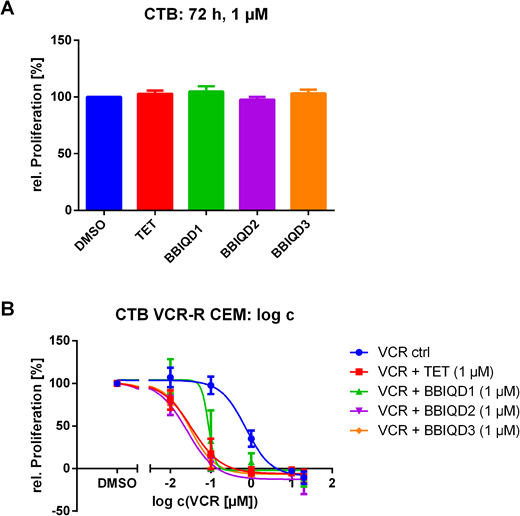Abstract
Introduction
Chemoresistance represents a major problem for the treatment of leukemia patients, which frequently manifests in the multidrug resistance (MDR) phenotype1. The drug refractoriness to structurally related and unrelated drugs can be caused by the P-glycoprotein (P-gp), an efflux pump belonging to the superfamily of ATP-binding cassette (ABC) proteins1, 2. Multiple large clinical studies have evaluated the effectiveness of potential P-gp inhibitors, but all of them failed clinically, except for the alkaloid tetrandrine (TET)3. Given the high structural complexity and the pulmonary toxicity of the plant-derived TET in animal studies4, we are seeking to develop new bisbenzylisoquinoline derivatives (BBIQDs) with similar potency and reduced toxicity to overcome P-gp-mediated chemoresistance in leukemia.
Methods
Calcein-AM, Cell-TiterBlue® cell viability and propidium iodide cell death were performed as described by the manufacturers. TUNEL assays were conducted as described previously5. For the assessment of in vivo toxicity, female C57BL/6-Tyr mice (Envigo) were treated with 57 or 90 nmol/kg of the corresponding P-gp inhibitor on three consecutive days.
Results
BBIQDs were synthesized and screened for their potential to inhibit P-gp-mediated drug efflux using calcein-AM as model substrate in vincristine-resistant leukemia cells (VCR-R CEM). The in vitro characterization revealed small molecule hits with a similar potency compared with the reference molecule TET. Consequently, the lead compounds were able to overcome chemoresistance to vincristine (VCR) when applied as a combination therapy, as assessed by cell viability and cell death assays. More specifically, the usage of P-gp inhibitors as add-on to VCR enabled a decrease of the IC50 value from 0.73 µM to up to 0.03 µM, corresponding to a maximum dose modifying factor of 24. Additionally, the ability of BBIQDs to reverse chemoresistance to imatinib in MDA cells overexpressing the breast cancer resistance protein (BCRP), another major efflux transporter responsible for MDR in leukemia6, 7, was tested. As no relevant chemosensitization was observed here, we concluded that our BBIQD hits are specific inhibitors of P-gp. Furthermore, in vivo toxicity was evaluated in a mouse model, showing that the BBIQDs were well-tolerated at the highest tested dose of 90 nmol/kg. Additionally, TUNEL assays on organ slides indicated lack of toxicity in lungs, heart and brain. Finally, the P-gp inhibitors will be tested for their efficacy to overcome chemoresistance in vivo using a zebra fish leukemia model.
Conclusion
Taken together, we have identified derivatives of the alkaloid TET with a similar potency to inhibit P-gp mediated drug efflux. Remarkably, the application of the BBIQDs as add-on to VCR was able to reverse chemoresistance in P-gp-mediated, VCR-resistant leukemia cells, while no toxicity issues were observed in a mouse model.
References
Marin, J.J., Briz, O., Rodriguez-Macias, G., Diez-Martin, J.L. & Macias, R.I. Role of drug transport and metabolism in the chemoresistance of acute myeloid leukemia. Blood Rev30, 55-64 (2016).
Joshi, P., Vishwakarma, R.A. & Bharate, S.B. Natural alkaloids as P-gp inhibitors for multidrug resistance reversal in cancer. Eur J Med Chem138, 273-292 (2017).
Kelly, R.J. et al. A pharmacodynamic study of the P-glycoprotein antagonist CBT-1(R) in combination with paclitaxel in solid tumors. Oncologist17, 512 (2012).
Jin, H. et al. Pulmonary toxicity and metabolic activation of tetrandrine in CD-1 mice. Chem Res Toxicol24, 2142-2152 (2011).
Leanza, L. et al. Direct Pharmacological Targeting of a Mitochondrial Ion Channel Selectively Kills Tumor Cells In Vivo. Cancer Cell31, 516-531 e510 (2017).
Burger, H. et al. Imatinib mesylate (STI571) is a substrate for the breast cancer resistance protein (BCRP)/ABCG2 drug pump. Blood104, 2940-2942 (2004).
Mao, Q. & Unadkat, J.D. Role of the breast cancer resistance protein (BCRP/ABCG2) in drug transport--an update. AAPS J17, 65-82 (2015).
No relevant conflicts of interest to declare.
Author notes
Asterisk with author names denotes non-ASH members.


